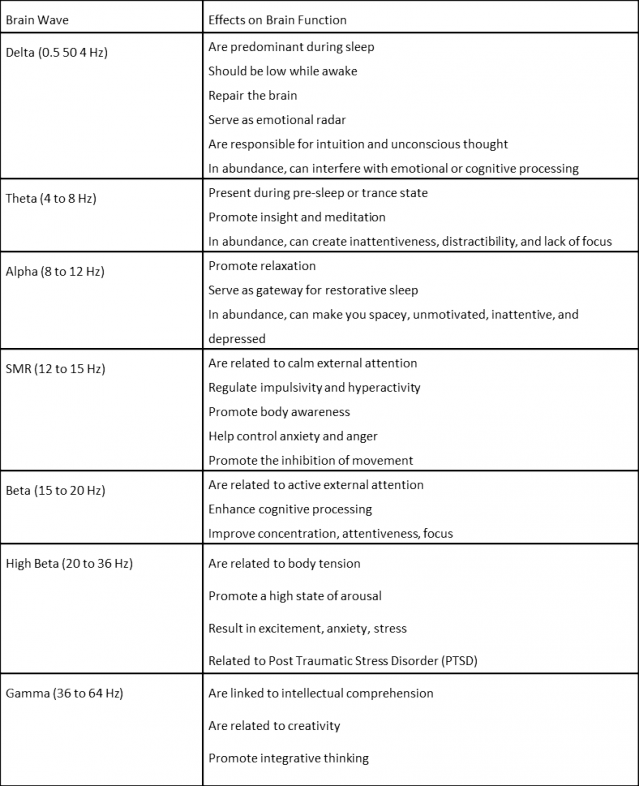Neurofeedback is effectively used to treat a wide variety of symptoms.
In my previous blogs in this series on Neurofeedback, I explain what it is and how it works. This blog is devoted to how Neurofeedback treatment is used for a wide variety of symptoms, such as anxiety, sleep problems, headaches, memory problems and ADHD along with causes relating to dysregulation of the brainwaves and/or neural hubs as seen in a Concussion, Stroke, MS, Autism, and Parkinson Disease, as well as how it is used for Brain fitness for athletes, executives and seniors.
To best understand how Neurofeedback is used for treatment, one must understand how the brain functions. The brain is made of over 100 billion neural cells and these cells are a part of a vast network of nerve connections through white matter, which includes specific neurotransmitters and neuromodulators (chemical messenger). A complete list of these and their functions is on page 13 of Coping with Concussion and Mild Traumatic Brain Injury, a book that I co-authored with Barbara Albers Hill.
It is the electrical system of the brain that allows communication between the various parts of the brain. What Neurofeedback is capable of doing is capturing the electrical signal of the brain through metal electrodes, made of either tin, silver, silver/silver chloride or gold. The electrical signals are then amplified through an amplifier and then, depending on the specific software, displayed on a computer screen.
In 1929, Hans Berger was the first to identify and name Alpha and Beta waves, while E.D. Andria and Brian Mathews were the first to name Delta and Theta waves in 1930. Since then, many others have identified additional waves as seen in the table below. In the illustrated table it not only shows the name and frequency. It also provides the effects of these specific waves on brain function (see table).


In a brain map, called Quantitative EEG (QEEG), 19 electrodes are placed on the head individually or in a special cap and either conductive past, gel or saline solutions is used with these electrodes to send the signal to the amplifier. All 19 locations electrical signals are being recorded and provide the needed information of the amount (amplitude) of each frequency through the brain. Along with this is provided how the various hubs communicate with one another.
As mentioned in my previous blogs, I have had brain surgery. I have a hole in my brain. I’ve described these hubs as similar to the hubs in aviation and airlines. To fly from Boston to Atlanta, you must fly to Chicago. There isn’t a direct flight. However, Chicago doesn’t exist in my brain, it is offline. Thus, my brain had to form a new hub to Houston to get to Atlanta. The QEEG looks at each individual frequency from 1 Hz to 64 Hz; to see how to the hubs communicate and how the brain functions when your eyes are open, closed and doing specific tasks.
QEEG is not the only form of brain map, there are others use such as Loretta, which provides a 3-D view, which is similar to an MRI of the brain, while a LENS map that is done in a sequential process of the 19 leads, provides information of where the brain is stuck in a specific frequency and location.
There are two basic modes of Neurofeedback treatment. It is similar to buying clothing from a department store, clothing boutique or going to a tailor and having your clothing custom fitted. For the majority of symptoms, causes in brain rehabilitation and brain fitness, the standardize protocols developed by the various manufactures of Neurofeedback equipment are very effective.
Thus, if you had the standard ADD, or ADHD, you would do a protocol for increase SMR ( 13-15 hz) while decreasing Theta ( 4-8 hz ) and decreasing High Beta (20-32 hz). If you are using NeurOptimal, you would allow the brain to regulate itself without any major intervention. And for the most part these standardized methods alone as mention are very effective in changing symptoms and improving the dysregulation of the brain.
However, when you get into the causes of the various symptoms and are using only one standard protocol or equipment it is often ineffective. The most effective methods include a combination of home use, a neurofeedback tech under the supervison of a BCI certified provider or professional with training in neuroanatomy trained in multiple methods.

In the future blogs, I will be presenting in-depth methods, various treatments, protocols and methods that are used alone and in conjunction with one another for specific symptoms and causes, such as a Concussion or Stroke to help you regain your life again. Remember.... There is a Way!®
© 2014 Dr. Diane Roberts Stoler, Ed.D.


